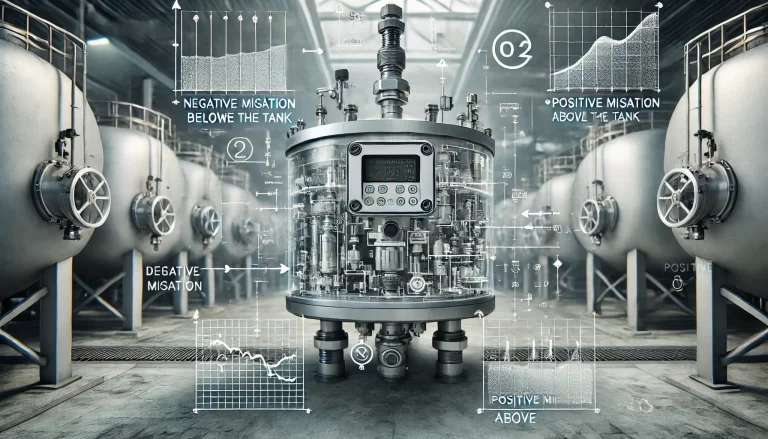In industrial applications, differential pressure transmitters are widely used for liquid level measurement in tanks and containers. During installation and configuration, terms like “negative migration” and “positive migration” often come up. These adjustments are crucial for ensuring accurate measurement. This article explores why negative and positive migration are necessary, how to calculate the migration amount, and when to use each method.
1. What is Negative Migration, and Why is it Necessary?
Negative migration involves adjusting the zero point of the differential pressure transmitter when the transmitter is installed below the reference zero point of the liquid level in the tank. The main purpose of negative migration is to eliminate the effect of the static pressure generated by the liquid column above the transmitter’s high-pressure side. Without this adjustment, the static pressure would be interpreted as part of the liquid level, leading to errors in measurement.
Example Scenario
Imagine a differential pressure transmitter installed 1 meter below the bottom of an open tank filled with water. The liquid column creates a static pressure due to its weight. Since the transmitter measures the pressure difference between its high-pressure side (connected to the tank bottom) and its low-pressure side (open to the atmosphere), this static pressure would skew the results unless compensated through negative migration.

2. How is the Migration Amount Calculated?
The migration amount is determined by the height difference between the transmitter’s installation point and the liquid level reference zero point, as well as the density of the liquid. The formula for calculating the migration amount is:
Migration Amount=ρ⋅g⋅h
Where:
- ρ is the liquid density (kg/m³),
- g is the gravitational acceleration (typically 9.8 m/s2),
- h is the vertical distance between the transmitter and the reference zero point (m).
Calculation Example
Suppose the transmitter is installed 1 meter below the liquid level reference zero point in a tank containing water (ρ=1000 kg/m3). The migration amount would be:
Migration Amount=1000⋅9.8⋅1=9800 Pa
This value is used to adjust the transmitter’s zero point downward by 9800 Pa to ensure accurate measurements.

3. When is Positive Migration Required?
Positive migration is necessary when the transmitter is installed above the liquid level reference zero point or when measuring liquid levels in pressurized containers where the gas phase above the liquid exerts additional pressure.
Scenarios for Positive Migration
Above the Reference Zero Point: If the transmitter is installed at a height above the reference zero point, the low-pressure side will experience a reduced pressure due to the height difference, resulting in a negative bias. Positive migration compensates for this by raising the zero point.
Pressurized Tanks: In sealed tanks, the low-pressure side of the transmitter is connected to the gas phase at the top of the tank. If this gas phase exerts a significant pressure, positive migration is required to account for this additional offset.
Positive Migration Calculation
The formula for positive migration is the same as for negative migration:
Migration Amount=ρ⋅g⋅h
Here, hhh represents the vertical distance between the reference zero point and the transmitter installation point or the equivalent height of the gas pressure.

4. Comparison of Negative and Positive Migration
| Type | When to Use | Effect |
|---|---|---|
| Negative Migration | Transmitter installed below the liquid level reference zero point. | Compensates for the static pressure of the liquid column, lowering the zero point. |
| Positive Migration | Transmitter installed above the liquid level reference zero point, or in pressurized tanks. | Compensates for the negative bias or gas-phase pressure, raising the zero point. |
5. Practical Considerations
When performing migration, consider the following:
- Liquid Properties: Ensure accurate values for density (ρ) and account for temperature effects, as density can change with temperature.
- Installation Conditions: Precisely measure the height difference (h) to avoid under- or over-compensation.
- Transmitter Calibration: After calculating and applying migration, always verify the transmitter’s output under real conditions to ensure proper calibration.

Conclusion
Negative and positive migration are essential techniques for achieving accurate level measurement in differential pressure transmitter systems. By understanding the principles and applying the correct migration type based on the installation scenario, operators can minimize measurement errors caused by static or gas-phase pressures. Proper calculation of migration amounts ensures reliable and precise operation, which is critical for maintaining efficiency and safety in industrial processes.
